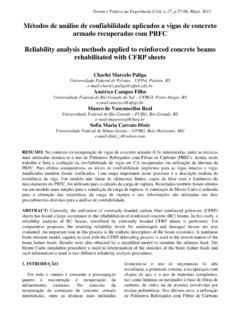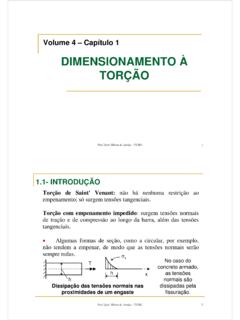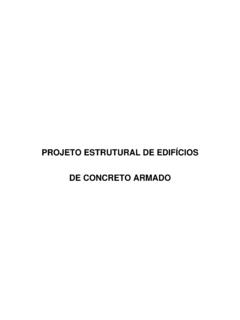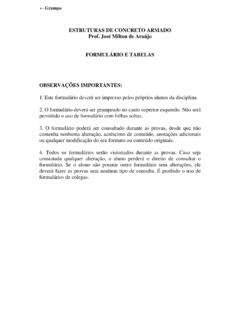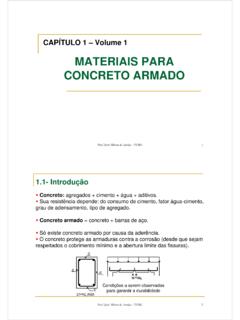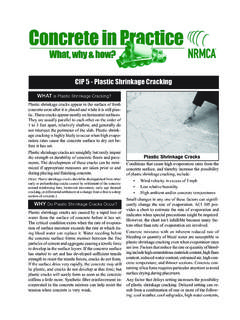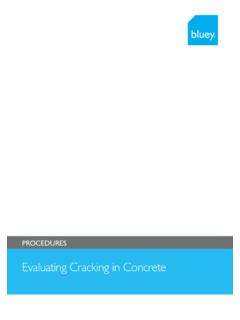Transcription of Simplified procedures for calculation of instantaneous and ...
1 Simplified procedures for calculation of instantaneous and long-term deflections of reinforced concrete beams Jos Milton de Ara jo1. Department of Materials and Construction, University of Rio Grande FURG. Campus Carreiros, Av. It lia, 96203-000, Rio Grande, RS, Brazil ABSTRACT. The Simplified methods of CEB and of ACI for prediction of deflections of reinforced concrete beams are analyzed in this work. Obtained results with those methods are compared with those obtained through a nonlinear analysis. Additional deflections due to creep and shrinkage are considered in the study. The obtained results indicate that the two Simplified methods are appropriate for calculation of instantaneous deflections of reinforced concrete beams. The method of CEB also supplies good results when creep and shrinkage of concrete are considered. However, the method of ACI is not satisfactory for evaluation of long-term deflections of reinforced concrete beams. 1. INTRODUCTION. Actual design procedures of reinforced concrete structures are based in concepts of limit states.
2 They are generally classified as ultimate limit states and serviceability limit states. The ultimate limit state refers to the bearing capacity of a structural part or of the structure as a whole. The serviceability limit states are associated with the structural performance under expected actions in normal conditions of utilization. In the verifications of the serviceability limit states, actions are considered with characteristic values, which is equivalent to consider partial safety factors equal to one. In the same way, mean mechanical properties of the materials are used to evaluate the structural rigidity. Usually, design codes for reinforced concrete structures require that beam deflections are calculated for the quasi-permanent combination of the actions. In each combination, permanent action is represented by a single representative value, g . Usually, this value is considered as a mean value, which is calculated from nominal dimensions of the structural elements. Variable actions are considered with the quasi-permanent value 2 q , where q is the characteristic value and 2 < 1.
3 This is the format of CEB-FIP Model Code (1993), for example. According to the Brazilian code NBR-8681 (ABNT(2003)), for the accidental loads of residential buildings and of office buildings, it is necessary to consider 2 = . In these cases, the quasi-permanent load p o is given by p o = g + (1). N mero 24, 2005 Engenharia Civil UM 57. where g and q are the characteristic values of the permanent load and the accidental load, respectively. In a consistent analysis of reinforced concrete beam, it is necessary to take into account the cracking and the tension stiffening effect. Creep and shrinkage of concrete should also be considered for calculation of long-term deflection. The analysis may be accomplished with different refinement levels, from the nonlinear analysis, until the utilization of Simplified formulas to represent an equivalent rigidity of the cracked beam, as in the Simplified method adopted in ACI Code (1995). This method of ACI. has been adopted in many national codes, as in EHE (1999) of Spain, in NBR-6118.
4 [ABNT(2004)] of Brazil, and in the codes of several countries of Latin America. On the other hand, the CEB (1985) recommends the use of the bilinear method, which is adopted in Eurocode 2 (2003) with small modifications. The objective of this work is to verify the precision of those two Simplified methods, which will be named method of ACI and method of CEB. The nonlinear model presented in the following section is considered as the reference model. 2. NONLINEAR MODEL FOR REINFORCED CONCRETE BEAMS ANALYSIS. The nonlinear model used in this work had its precision demonstrated in previous works [Ara jo (1991) and Ara jo (2003)] and it allows obtaining the probable deflections of reinforced concrete beams. The stress-strain diagram for concrete subjected to compression is shown in Fig. 1. c fc Ece 1. o u c Fig. 1 Stress-strain diagram for concrete in uniaxial compression According to CEB (1993), the compression stress c , is given by k 2 . c = fc (2). 1 + (k 2) . where k = E ce o f c ; = c o and c is the compression strain.
5 For the strain o , corresponding to the peak compressive stress f c , the value o = (1 + ) is adopted, where is the creep coefficient. The ultimate strain is u = (1 + ) . 58 Engenharia Civil UM N mero 24, 2005. The initial modulus of elasticity of concrete, Ec , may be estimated from the mean compressive strength, f c , by means of relation E c = 21500 ( f c 10)1 3 (3). where f c and Ec are given in MPa. According to CEB (1993), the mean strength for use in expression (3) may be estimated as f c = f ck + 8 MPa (4). where f ck is the characteristic compressive strength of concrete, given in MPa. For long-term loading, the total deformation including creep is calculated by using an effective modulus of elasticity for concrete, Ece , given by E ce = E c (1 + ) (5). For concrete subjected to tension are adopted the stress-strain diagrams indicated in Fig. 2. ct =0 >0. fct ct,lim Ec Ece cr (1+ ) cr ct Fig. 2 Stress-strain diagrams for concrete in tension The tensile stress ct is given by E ce ct , se ct (1 + ) cr ct = (6).
6 Ct ,lim , se ct > (1 + ) cr where ct is the tensile strain and ct ,lim is the maximum tensile stress for cracked concrete, given by . ct ,lim = f ct cr (7). ct . where cr = f ct E c is the cracking strain of concrete for short-term loads. The expression (7) takes into account the tension stiffening effects and reproduces the experimental results satisfactorily, as it may be verified in Ara jo (1991). According to CEB (1993), axial tensile strength f ct may be estimated through the expression N mero 24, 2005 Engenharia Civil UM 59. 23. f . f ct = 1,40 ck (8). 10 . with f ck and f ct given in MPa. As it may be observed, the constitutive model is an extension of the effective modulus method for the nonlinear case. This model is satisfactory when the history of stress is characterized by limited variations during the aging of concrete. When great stress variations occur during the aging period, the model may be improved applying the adjusted effective modulus method, as in Ghali and Favre (1986) and in CEB (1984).
7 That is equivalent to consider an adjusted creep coefficient a = , where is the aging coefficient. In the practical applications = may be adopted. In this work = 1 is adopted because it is admitted that the quasi-permanent load p o doesn't vary along the time. The total strain of concrete, c,tot , is given by c,tot = c + cs (9). where c is the stress dependent strain and cs is the shrinkage strain. Therefore, the stresses in the concrete may be obtained with the previous model considering the portion of the strain c = c,tot cs . The structural analysis is made by means of the finite element method. The finite element used is the classic element for plane frames, with two nodes and three degrees of freedom for node. Three Gauss integration points are considered along the finite element length, for determination of the nodal nonlinear actions. At each integration point the concrete cross-section is discretized in n = 30 layers in the height direction. The resistant sectional forces are obtained considering the stresses in the reinforcement and in the center of each concrete layer [Ara jo (1991)].
8 Using the finite element method, the strain x in a generic layer of the cross-section, located to a distance z from centroidal axis of the gross section, neglecting reinforcement, is given by x = xo + z (10). where xo and represent the axial strain and the curvature, obtained through the nodal displacements of the element. The expression (10) supplies the total strains in the concrete, including creep and shrinkage. The mechanical strain c is given by c = xo + z cs (11). where z = z i , with i = 1,.., n , represents the distance of the center of concrete layer until the centroidal axis of gross section. After the calculation of the strain c , the constitutive model is used to obtain the stress in the center of each concrete layer. The expression (10) is also used to calculate the strain in each steel layer, being enough to use for z the distance of the steel layer to the centroidal axis of gross section. It is 60 Engenharia Civil UM N mero 24, 2005. assumed that the reinforcing steel presents a perfect elastic-plastic behavior in tension and in compression.
9 Using the finite element method it is obtained the displacements of the structure at a certain load level. The nonlinear equations system, due to material nonlinearities, is solved iteratively using the BFGS method. Small load increments are applied on the beam until the rupture occurs. Occurrence of the rupture is admitted when the compression strain in the concrete results smaller or equal the u = (1 + ) , or when the tensile strain in the steel reaches the value limits of . 3. Simplified PROCEDURE OF ACI. According to ACI Code (1995), instantaneous deflections of reinforced concrete beams, W (t o ) , shall be computed with the effective moment of inertia I e , given by Mr . 3 M . 3 . Ie = I c + 1 r I2 Ic (12). M M . where I c = moment of inertia of gross concrete section about centroidal axis, neglecting reinforcement; I 2 = moment of inertia of cracked section transformed to concrete; M =. maximum moment in member at stage deflection is computed; M r = cracking moment. The cracking moment is given by I f M r = c ct (13).
10 Yt where yt is the distance from centroidal axis of the gross section, neglecting reinforcement, to extreme fiber in tension. Thus, for a rectangular section result the expression M r = bh 2 f ct 6 . For prismatic members, effective moment of inertia I e may be calculated considering the geometrical properties of the critical section. ACI Code adopted different expressions for the modulus of elasticity and for the tensile strength of concrete. However, Ec and f ct will be calculated through the expressions (3) and (8) for those properties to be the same in all the analyzed methods. To consider possible material nonlinearities, rigidity is evaluated with the secant modulus of elasticity E cs = c . Thus, deflections are calculated considering the effective rigidity given by Ecs I e . Additional long-term deflection, W , resulting from creep and shrinkage, is obtained by . W = W (t o ) (14). 1 + 50 '. where W (t o ) is the instantaneous deflection caused by the sustained load and = As (bd ) is the compression reinforcement ratio on the critical section.
